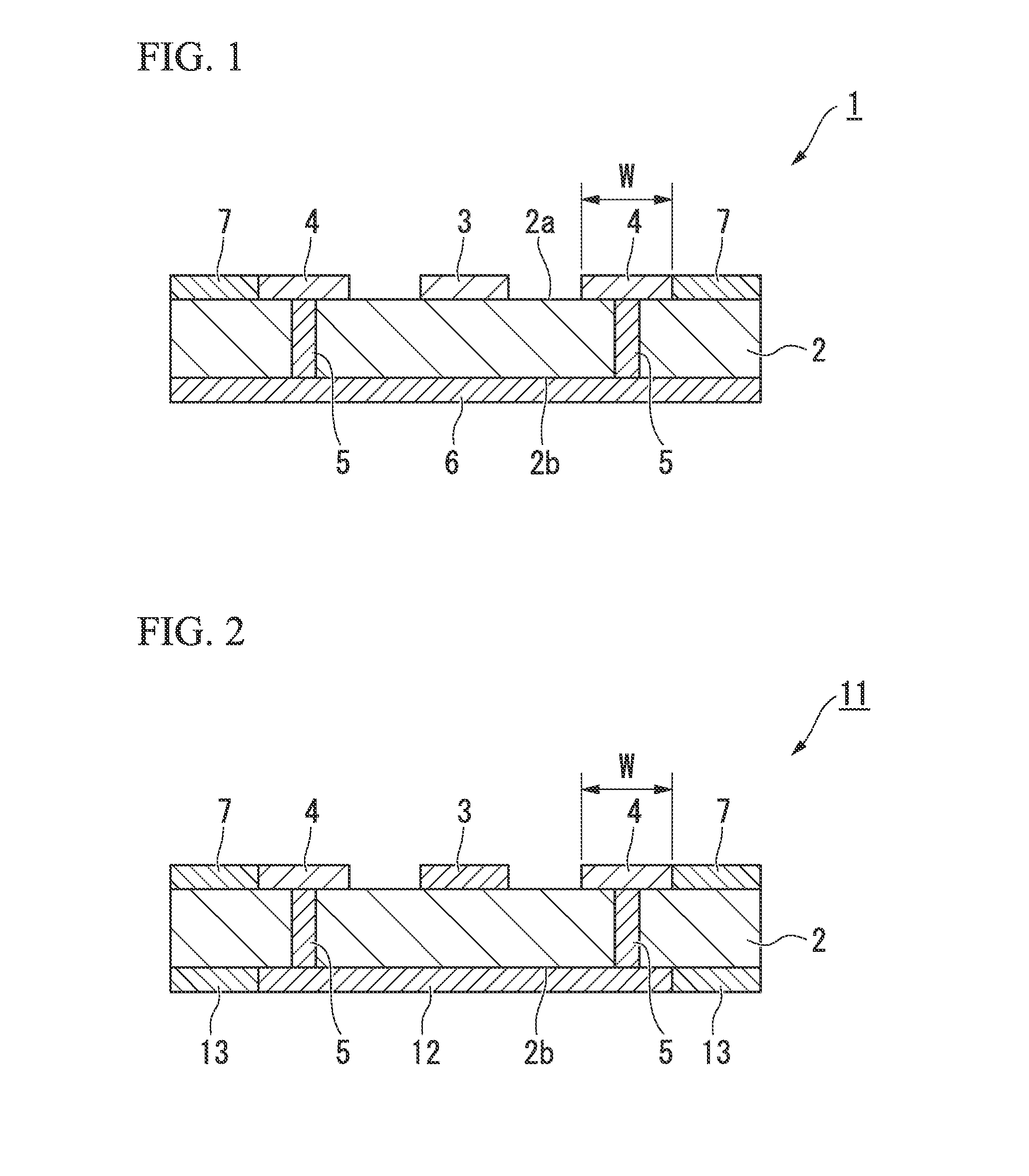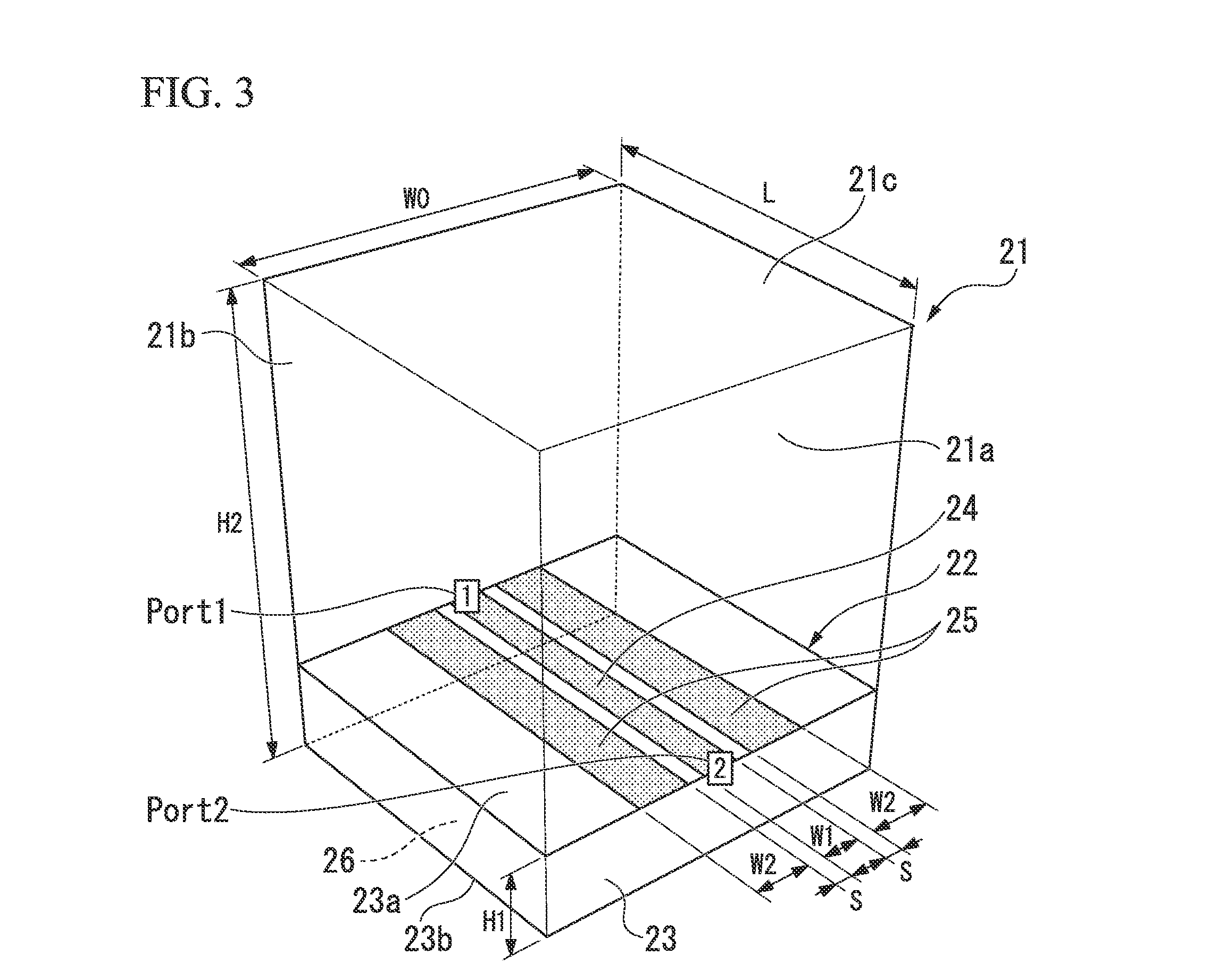Transmission line used to transmit high-frequency electrical signals
- Summary
- Abstract
- Description
- Claims
- Application Information
AI Technical Summary
Benefits of technology
Problems solved by technology
Method used
Image
Examples
first embodiment
[0042]FIG. 1 is a cross-sectional view of a GCPW-type transmission line used to transmit high-frequency electrical signals according to a first embodiment of the invention, and illustrates a transmission line that can deal with high-frequency electrical signals having frequencies of 20 GHz or higher. In the drawing, reference sign 1 represents a GCP-type transmission line used to transmit high-frequency electrical signals, in which a signal line 3 used to transmit high-frequency electrical signals is formed on a front surface (one principal surface) 2a of a dielectric substrate 2, GND electrodes (first ground electrodes) 4 are formed outside the signal line 3 and in vicinities of end portions of the front surface 2a, and a GND electrode (second ground electrode) 6 that is electrically connected to the GND electrodes 4 through via holes 5 is formed across an entire rear surface (the other principal surface) 2b of the dielectric substrate 2.
[0043]In addition, band-shaped resistors 7 t...
second embodiment
[0058]FIG. 2 is a cross-sectional view of a GCPW-type transmission line used to transmit high-frequency electrical signals according to a second embodiment of the invention, and the differences of the transmission line used to transmit high-frequency electrical signals 11 of the present embodiment from the transmission line used to transmit high-frequency electrical signals 1 of the first embodiment are as follows. While the GND electrode 6 is formed across the entire rear surface 2b of the dielectric substrate 2 in the transmission line used to transmit high-frequency electrical signals 1 of the first embodiment, in the transmission line used to transmit high-frequency electrical signals 11 of the embodiment, a GND electrode (second ground electrode) 12 that has a smaller area than the GND electrode 6 in the first embodiment and is electrically connected to the GND electrodes 4 through the via holes 5 is formed on the rear surface 2b of the dielectric substrate 2, and (second) band...
examples
[0066]Hereinafter, the invention will be specifically described using an example and a conventional example, but the invention is not limited to the examples.
Conventional Example
[0067]FIG. 3 is a view illustrating a conventional GCPW-type transmission line used to transmit high-frequency electrical signals (hereinafter, referred to shortly as GCPW-type transmission line) formed in a hexahedral metal box filled with air. In the drawing, reference sign 21 represents the metal box, and has a hexahedral structure formed by assembling metallic walls 21a, 21b, 21c, . . . in a box shape.
[0068]In addition, reference sign 22 represents the GCPW-type transmission line, a signal line 24 used to transmit high-frequency electrical signals is formed on a front surface 23a of a dielectric substrate 23, GND electrodes (first ground electrodes) 25 and 25 are formed outside the signal line 24, and a GND electrode (second ground electrode) 26 that is electrically connected to the GND electrodes 25 and...
PUM
 Login to View More
Login to View More Abstract
Description
Claims
Application Information
 Login to View More
Login to View More - Generate Ideas
- Intellectual Property
- Life Sciences
- Materials
- Tech Scout
- Unparalleled Data Quality
- Higher Quality Content
- 60% Fewer Hallucinations
Browse by: Latest US Patents, China's latest patents, Technical Efficacy Thesaurus, Application Domain, Technology Topic, Popular Technical Reports.
© 2025 PatSnap. All rights reserved.Legal|Privacy policy|Modern Slavery Act Transparency Statement|Sitemap|About US| Contact US: help@patsnap.com



